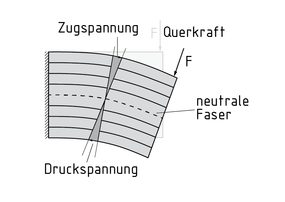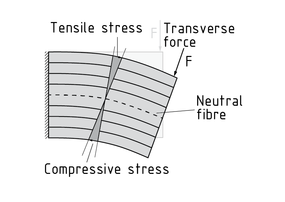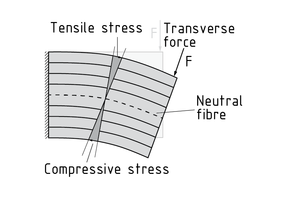
Choose one
or multiple languages
0,1,1
- German
- English
- Chinese
- Spanish
Bending moment

The Bending moment M is responsible for bending thin bodies. It induces internal forces in an element that are distributed over the component's cross-section and length.
A bending moment occurs, for example, due to a transverse Force F or distributed load acting perpendicular to the body's longitudinal axis. On a beam subjected to this type of load, the surface on which the force acts is subject to tensile stress and the opposite side to compressive stress. The neutral fibre is located at the transition from tensile to compressive stress.
If the bending moment is the only stress resultant acting in a beam, the result is known as pure bending.
Consequently, materials of a component subjected to bending stresses should exhibit properties suitable for both tensile and compressive stresses.
Biegemoment

Das Biegemoment M ist für die Biegung von schlanken Körpern verantwortlich. Es löst innere Kräfte in einem Element aus, die über den Querschnitt und die Länge des Bauteiles verteilt sind.
Ein Biegemoment entsteht z. B. durch eine senkrecht zur Längsachse des Körpers wirkende Querkraft F oder Streckenlast. Ein in dieser Form belasteter Balken wird an der Oberfläche, auf die die Kraft wirkt, auf Zug und an der gegenüberliegenden Seite auf Druck beansprucht. Am Übergang von Zug- zur Druckbeanspruchung befindet sich die neutrale Faser.
Ist das Biegemoment die einzig wirkende Schnittgröße in einem Balken, entsteht eine sogenannte reine Biegung.
Werkstoffe eines auf Biegung beanspruchten Bauteils sollten folglich geeignete Eigenschaften für Zug- als auch Druckbeanspruchungen aufweisen.
弯矩

弯矩 M是弯曲细长物体时产生的。。由分散在内部截面和长度方向的力引起
弯矩的产生是由于横向力 F 或其他分布力垂直作用于物体的纵轴上。承受此类力的梁,受力表面产生拉伸应力而相反侧产生压缩应力,其中间单元从拉伸应力向压缩应力转变。
假设梁受到应力作用后只产生弯矩,称为纯弯曲。
因此,构件材料受到弯曲应力后会显示出其拉伸和压缩应力的性能。
弯矩作用下产生的弯曲
Momento de flexión

El momento de flexión M es responsable de la flexión de los cuerpos delgados. Induce fuerzas internas en un elemento que se distribuyen sobre la sección y la longitud del componente.
Un momento de flexión ocurre, por ejemplo, debido a una fuerza transversal F o carga distribuida que actúa de forma perpendicular al eje longitudinal del cuerpo. En una viga sujeta a este tipo de carga, la superficie sobre la cual actúa la fuerza se somete a un esfuerzo de tensión y el lado opuesto a un esfuerzo de compresión. La fibra neutral está ubicada en la transición del esfuerzo de tensión al de compresión.
Si el momento de flexión es el único resultado del esfuerzo que actúa sobre una viga, el resultado es conocido como flexión pura.
Por consiguiente, los materiales de un componente sujeto a esfuerzos de flexión deben mostrar propiedades adecuadas tanto para los esfuerzos de tensión como de compresión.
Flexión causada por un momento de flexión
